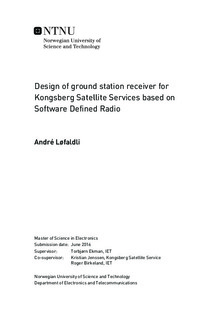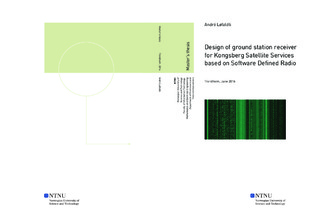| dc.description.abstract | As the space industry keeps growing, the need for low cost solutions increases.
This applies not only to the launch vehicles and space segments, but also to the ground station systems.
In this report, a software defined radio (SDR) ground station receiver implemented.
It features an Ettus Research USRP SDR which converts an analog signal to a digital baseband representation.
The baseband signal, is sent to a host computer, which runs an application that demodulates and decodes the incoming signal to extract the transmitted data.
The software component is built with GNU Radio, an open source toolkit with a rich set of signal processing features.
It is designed to use a CCSDS frame format, with forward error correction, and demodulate the signal using binary phase-shift keying (BPSK).
To synchronize to the symbol timing and carrier frequency of the incoming signal, a clock recovery algorithm is used in addition to a Costas Loop.
This accounts for frequency offsets between transmitter and receiver, including those from Doppler shifts.
The proposed system has been tested in two ways.
First at short range, between two SDR units, communicating in the VHF band using omnidirectional antennas.
Here, another application for uplink communication is implemented, also to be used with an SDR, representing the satellite.
The second test was done using the SDR to receive downlink data from a satellite in low earth orbit.
The satellite communicates on the S-band with a data rate of 2 Mbps.
Before the signal reaches the SDR it is processed by RF equipment and mixed down to an intermediate frequency of 70 MHz.
The results show that downlink reception from the space segment is possible.
Only a few of the received data frames had too many errors for the Reed Solomon decoder to be able to correct them.
Simulations show that the SDR would still be able to perform satisfactory at a lower SNR.
This could potentially allow for a cost reduction in the RF equipment. | |

